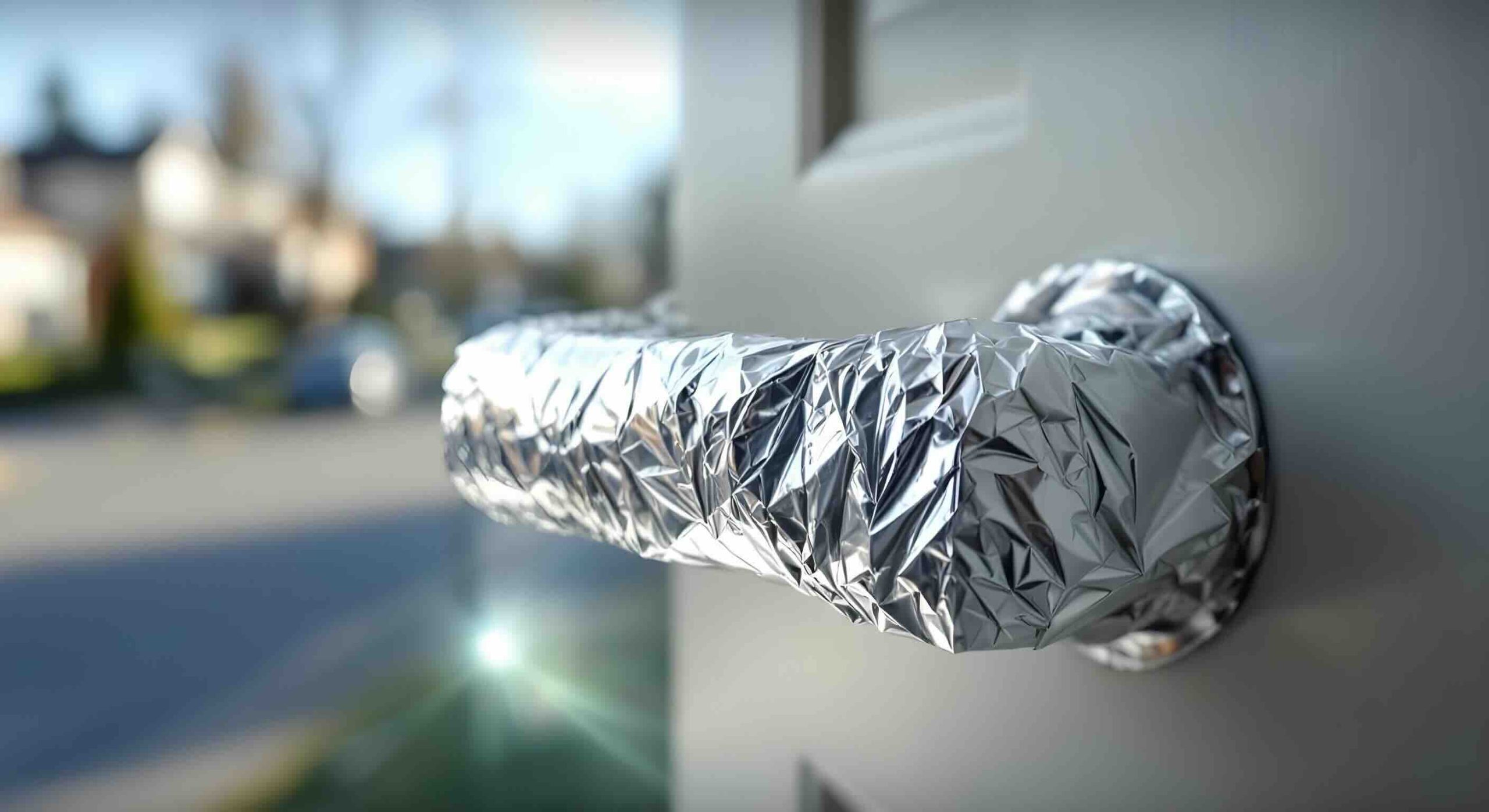A curious new trend has taken over social media platforms, claiming that wrapping aluminum foil around door handles can help prevent burglaries.
This viral “security hack” promises an easy, inexpensive, and almost magical way to protect your home.
But while the idea has captured the imagination of millions online, professionals in the security industry warn that it offers little to no real protection.
Videos and posts showcasing shiny door handles wrapped in crinkled foil have flooded TikTok, Facebook, and YouTube.
The simplicity of the hack—and the promise of quick safety without expensive equipment—has made it particularly popular among homeowners
preparing for vacation or extended absences. However, experts urge caution, emphasizing that while the concept is creative, it is far from reliable.
The viral trend behind aluminum foil security measures
The trend gained momentum as influencers and DIY security enthusiasts shared short clips demonstrating how to wrap handles with household aluminum foil.
The method involves tightly covering the door handle or knob with several layers of foil, leaving a smooth but reflective surface.
Proponents claim this can confuse or scare off potential intruders, who might interpret the unusual look as a sign of hidden alarm systems or cameras.
In these videos, content creators suggest that the foil serves multiple purposes:
it acts as a psychological deterrent, creates a distinctive sound when touched, and shows visible signs of tampering if disturbed.
The hack is described as a quick fix anyone can try at home—no tools, no installation, and no cost beyond a few cents’ worth of foil.
Like many viral home hacks, the aluminum foil trick appeals because it feels empowering.
It gives people a sense of control in a world where professional home security systems can be costly or intimidating to install.
Yet, just like other internet-born fads, what seems clever online often doesn’t translate to real-world effectiveness.
Claimed benefits of aluminum foil on door handles
Supporters of the aluminum foil technique commonly cite three main benefits: psychological deterrence, noise-based alerts, and visible tamper evidence.
Each of these supposed advantages sounds logical on the surface but falls apart under closer inspection.
Psychological deterrence: The unusual, metallic look may cause burglars to second-guess approaching a door.
The theory suggests that they could assume the home has an advanced security setup or sensors hidden beneath the foil, discouraging an attempted entry.
Noise generation: According to fans of the trend, the crinkling sound of aluminum foil could alert occupants or neighbors if someone touches the handle at night.
In theory, it becomes a low-tech early warning system using basic household materials.
Evidence of tampering: If the foil is torn or misshapen, it could indicate that someone has tried to manipulate the handle.
Homeowners could then recognize potential intrusion attempts before any serious damage occurs.
These claims make the trick sound appealing—simple, affordable, and even a little scientific.
However, real-world testing and expert evaluations paint a very different picture.
Professional security experts debunk the aluminum foil myth
Law enforcement agencies and certified home security specialists have spoken out to debunk this viral phenomenon.
Police departments in Germany and the United States have warned that wrapping aluminum foil around door handles provides no actual protection
against burglars and can even create a false sense of safety.
Security experts emphasize that burglars rarely attempt entry through a single point like the front door.
Windows, garage entries, and side doors are often easier and less visible targets.
Focusing security efforts on a shiny door handle while ignoring the rest of the property leaves significant vulnerabilities.
The idea that aluminum foil could generate an audible alert is also impractical.
The sound produced by handling or brushing against foil is subtle and easily drowned out by background noise—especially in urban or suburban environments.
Even in quiet areas, it is unlikely to wake a sleeping homeowner or alert a neighbor across the street.
Another problem lies in perception.
Far from deterring intruders, a foil-wrapped door handle may suggest that the property owner relies on DIY fixes rather than real security systems,
making the home appear less professionally protected.
Some experts argue this could even attract opportunistic burglars who recognize the trend.
Most importantly, using foil as a security measure may encourage complacency.
Believing that a simple trick is enough can cause homeowners to overlook effective safety habits—like locking windows,
setting alarms, or installing outdoor lighting.
In the end, this “hack” could leave homes more vulnerable rather than more secure.
Recommended alternatives to aluminum foil security tricks
Instead of relying on viral trends, experts recommend proven, evidence-based methods to protect your property.
Good home security doesn’t have to be expensive—it’s about consistency, awareness, and a few smart investments.
- Secure all entry points: Always lock doors and windows, even when you’re home. Check them before sleeping or leaving the house.
- Upgrade your locks: Install high-quality deadbolts or smart locks that provide better resistance to tampering.
- Install motion sensors and alarms: Motion-activated lights and audible alarms deter burglars before they even touch the door.
- Use surveillance cameras: Smart security cameras can send instant alerts to your phone and record suspicious activity.
- Join community watch programs: Neighborhood vigilance remains one of the most effective deterrents to crime.
- Maintain good lighting: Keep entrances well-lit. Criminals prefer darkness and obscurity, not exposure.
Additionally, small behavioral habits make a big difference: don’t advertise travel plans on social media,
ask a trusted neighbor to collect your mail when you’re away, and use timers for indoor lights to simulate presence.
These steps are simple yet proven to reduce burglary risks.
